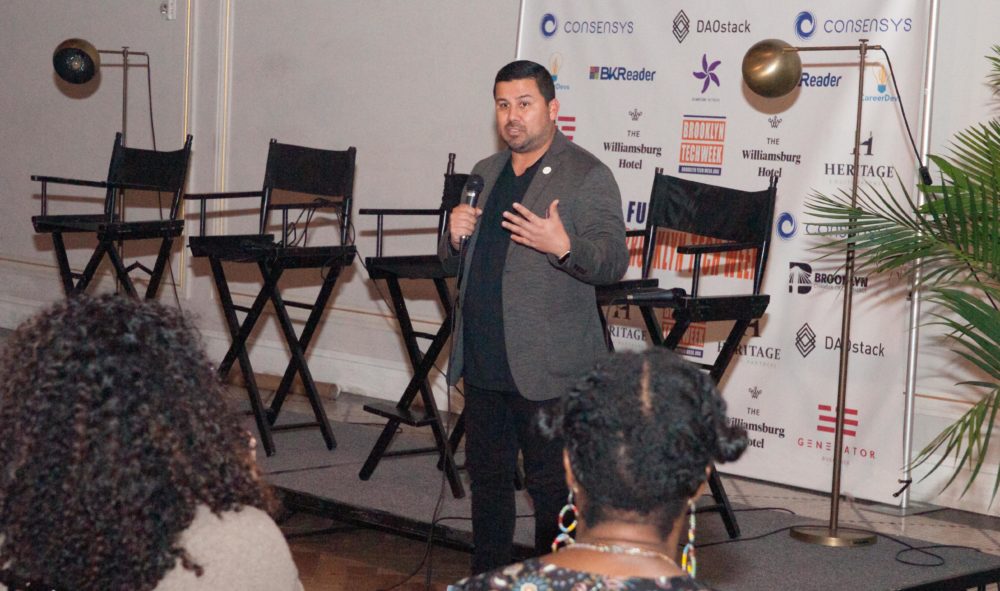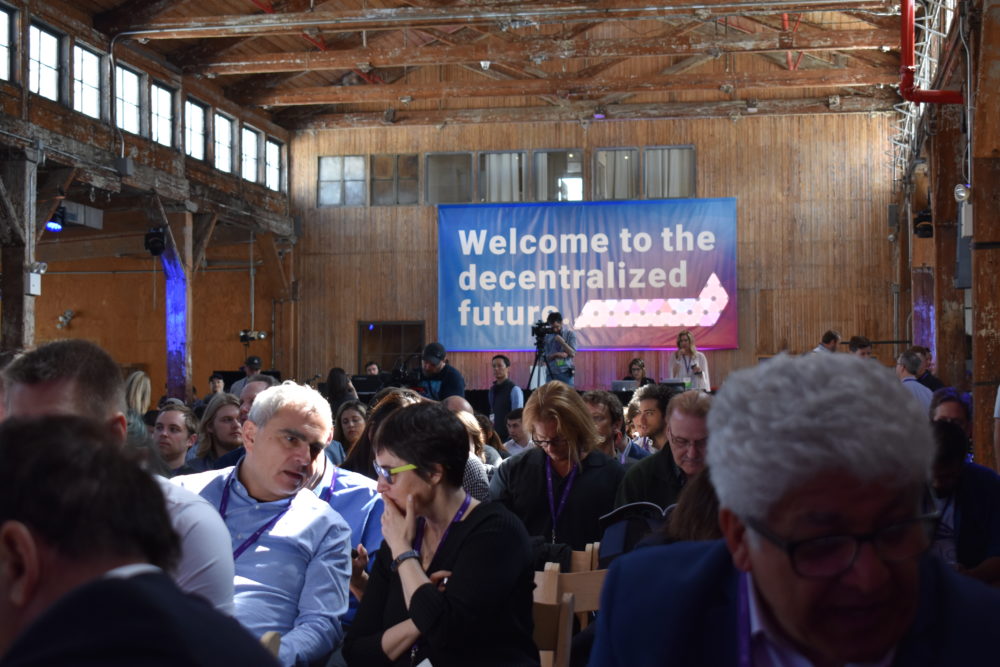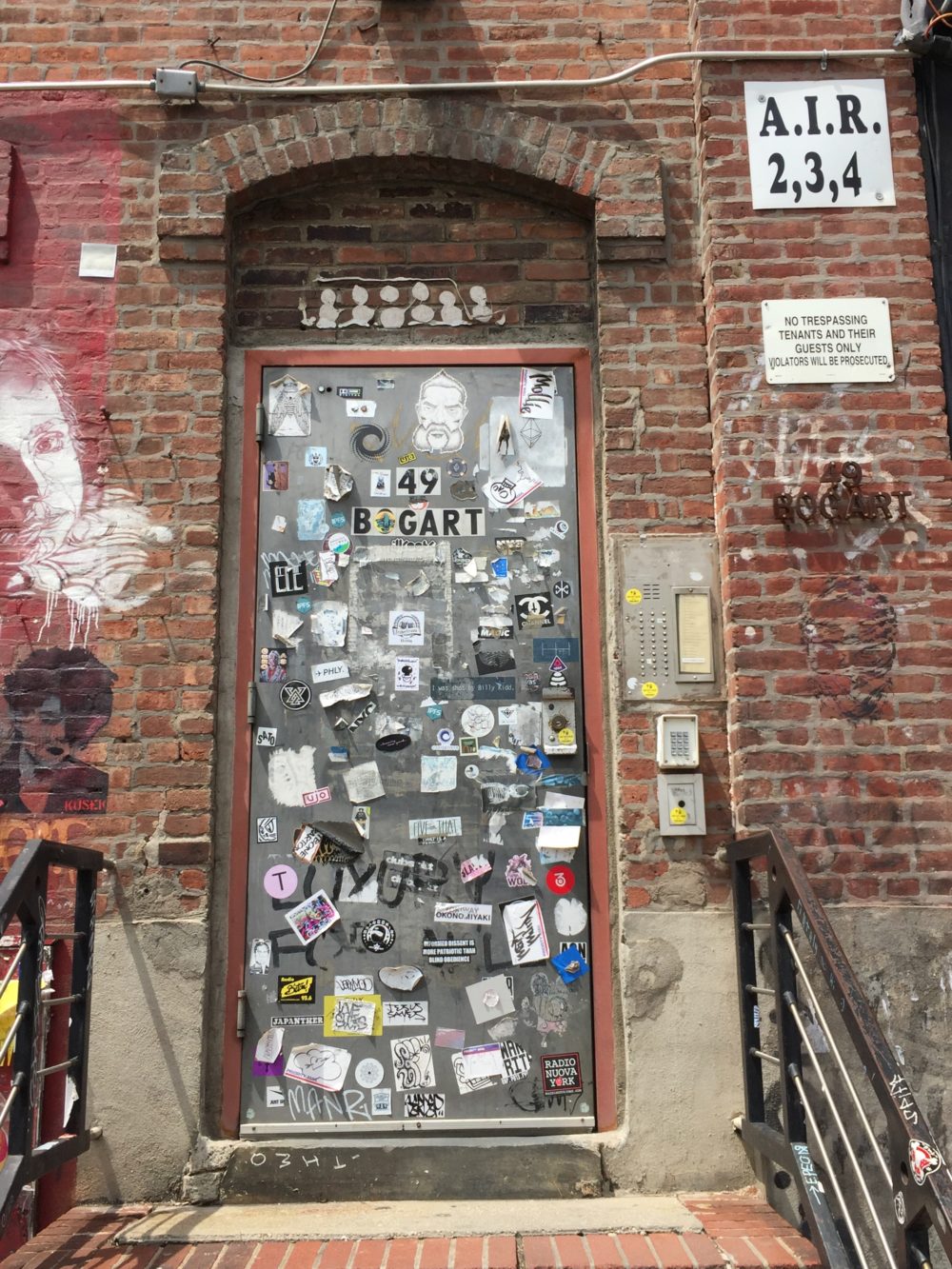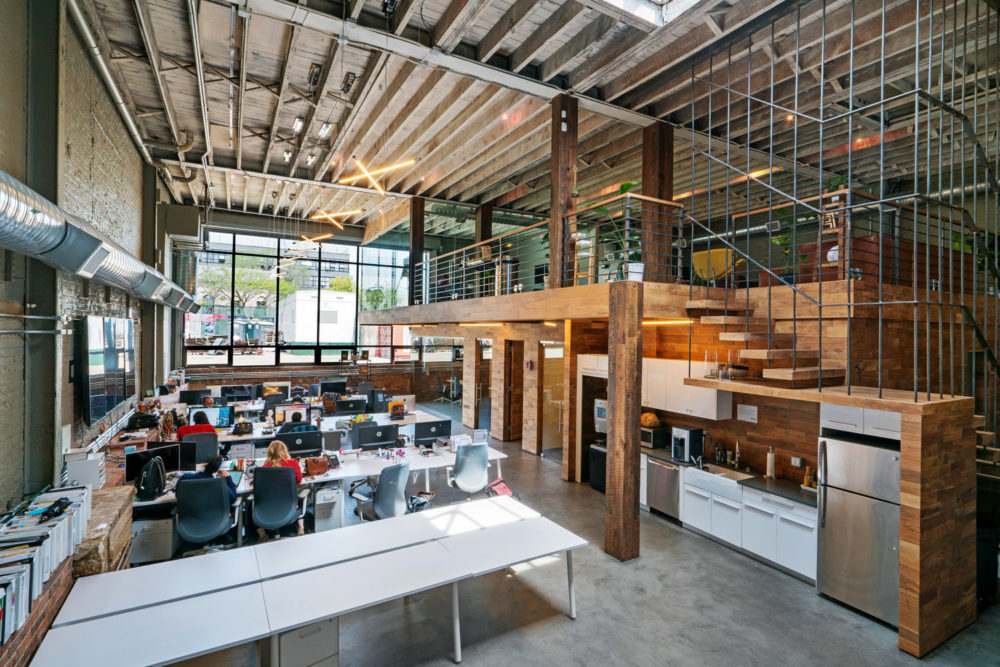Certain parts of Brooklyn these days feel like a version of what you might imagine the early days of Silicon Valley were like while the internet was being born. Excited developers and entrepreneurs are leaving behind the suits and briefcases and glass towers of Manhattan for startup T-shirts, jeans, book bags, and renovated factories. This time around, the tech set is working around the clock to produce what they think will be the new internet: the blockchain.
Last week many of them gathered in the Williamsburg Hotel for a conference called Brooklyn Tech Week, hosted by the hotel’s Brooklyn-born and based owners, Heritage Equity Partners, and featuring many speakers from Brooklyn’s (and maybe the world’s) largest blockchain company, ConsenSys.
In the last two years, blockchain technology, and the tokens based on it, cryptocurrencies, have been both the hottest and the most overheated subjects in the technology world. East Williamsburg-based ConsenSys, which develops applications for the Ethereum blockchain platform, was founded in 2015 and already has about 1,200 employees around the world.

New York City’s interim chief technical officer, M. Alby Bocanegra, welcomed attendees at the Williamsburg conference last week (Photo courtesy of Brooklyn Tech Week)
“Last year was all about buying Lambos. This year we all have to debate Nouriel Roubini,” said ConsenSys’s chief marketing officer, Amanda Gutterman, referencing Lamborghinis, a symbol of the quick fortunes made in cryptocurrencies and the economist nicknamed “Dr. Doom,” who gained fame by correctly predicting the financial crisis a decade ago and who now has staked out a space for himself as the preeminent blockchain bear.
Will blockchain revolutionize the infrastructure of the global financial system—and even much more? Is it fool’s gold? And outside the hype, what is actually happening with the technology that has found a home base here in Brooklyn? We headed to the conference to try to get some answers on the current state of blockchain technology.
A Regular, Struggling Business
One thought many people sounded at the conference was a recognition that the cryptocurrency party had come and gone. Now it’s a question of how long into the next afternoon the hangover would last. Last fall and winter, cryptocurrencies across the board, but led by bitcoin and ether, experienced a speculation boom with few precedents in human history, enriching those early adopters who owned tokens. This year has brought an unwinding of that speculation, with the prices of nearly all cryptocurrencies retreating between 50% and 75%.
Brittany Laughlin is a partner at Lattice Ventures, a seed-stage fund that invests in many blockchain companies. During her panel discussion, she said that it’s time for blockchain startups to reign in their predictions and start producing.
“There are these very grandiose plans. People say ‘We’re going to be the new internet.’ Okay, how are you going to do that?”
It was a thought seconded by Charlie O’Donnell, a venture capitalist who started the fund Brooklyn Bridge Ventures. He said in his keynote that the companies in the blockchain space needed to start answering the same questions startups in any industry have had to answer for decades: Does someone want to buy what I just built? Does a consumer want to use what I just made?

Earlier this year, the Ethereal Summit, hosted by ConsenSys, drew an estimated 2,000 blockchain aficionados (Photo by Steve Koepp)
“I think there was a time when investors got very excited about the use of blockchain and there was a land grab to jump into the space, but I think that window is closing and they want to see market size and traction and the same questions we’ve always had,” he said.
Yossi Hasson, the managing director of the startup incubator TechStars, likened blockchain to the birth of the internet, but noted that the internet did actually take a long time to reach its promise, and had plenty of false starts.
“In blockchain we’re still sort of in the Linux phase but we’re seeing people trying to build the new Facebook,” he said in a panel. “You still have to build the infrastructure. Right now the infrastructure is slower and harder to use than its competitor, which is cloud-based technology… We are seeing some applications, but there’s very few that actually fit into the box of why it’s important to use blockchain.”
Many people at the Brooklyn event had been at a different conference the week before, DevCon IV, in Prague, Czechia. DevCon is an annual conference for Ethereum developers that has grown in recent years to be one of the toughest tickets in the blockchain world.
Sam Cassatt, the chief strategy officer at ConsenSys, told The Bridge it had a different feel this year.
“In previous times, when people were just focusing on the [cryptocurrency] price and there’s a lot of exuberance, there were a lot of people trying to capitalize on that exuberance and trying to shill their random token project,” he said. “At DevCon last week, there was a lot of focus on core platforms, on ideas, on pushing the next boundary and I think that’s a really healthy thing. It shakes out some of the noise.”
The Blockchain Impact in Brooklyn
Based in a sticker and graffiti-covered brick building in East Williamsburg, ConsenSys was one of the first blockchain companies, founded by the co-creator of the Ethereum blockchain (the second-largest blockchain after Bitcoin), Joseph Lubin. He is thought by some to be the single largest holder of Ether, and in February, Forbes estimated his fortune to be between $1 billion and $5 billion, although the price of ether has dropped by 75% since then. Still, ConsenSys is a hub of economic activity, a new industry on a block of old factories and warehouses that have been converted into co-working spaces and cafes.
“When people come from international consulting firms and I see people walking down the street looking confused in Bushwick, I tell them it’s actually that door there with the stickers and graffiti on it,” Cassatt explained, with a laugh.

The famous sticker-covered front door of the building housing ConsenSys in East Williamsburg (Photo by Steve Koepp)
Aside from the jobs, there are ancillary economies growing up around the blockchain space in Brooklyn as well. Around the corner from ConsenSys’s headquarters is a building called the Bushwick Generator. Currently, the space is being used as a “community oriented innovation hub” and when it’s fully built out will bring 100,000 sq. ft. of office and retail space to East Williamsburg. The space holds a regular blockchain meetup and is the base of an organization called the Bushwick Blockchain Alliance. It’s owned by Heritage Equity Partners, headed by Brooklyn real-estate maven Toby Moskovitz, and received a more than $30 million loan from Jared Kushner’s Kushner Credit Opportunity Fund to bring the renovated industrial building online.
It’s not just real estate, though. We met a media entrepreneur, Rachel Siegel, who lives in Bushwick and recently created a design business around blockchain technology. She was at the conference for networking, she told The Bridge. Her company, Blocknoodle, is an animation company that creates marketing videos for blockchain startups explaining what they do. Siegel said business is good. In fact, she recently expanded her repertoire to include viral video production. Her most recent work, Top Six, features her writhing on the steps of the New York Stock Exchange in underwear bearing the XRP brand (another cryptocurrency) singing a rewritten version of Britney Spears’ Toxic. (Top Six refers to the top six cryptocurrencies.) The video generated a few thousand views on YouTube and dozens of comments on Reddit.
“My thesis is there’s no way to get a common consumer invested in cryptocurrency, wondering what’s going on about blockchain technology,” if the message is too tech-heavy, she told The Bridge. “Not everyone can understand that.”
All of it fits into a trend of tech companies increasingly starting in Brooklyn and foregoing the crossing of the East River, said Charlie O’Donnell, in his keynote.
“Over the last ten years the critical mass of people who start companies is more likely to live in Brooklyn than in any other place. When people start thinking of lifestyle and family and commute people are wondering, ‘Why am I commuting into the city?’ There’s a lot more co-working spaces in Brooklyn. There’s now three or four VC firms located in Brooklyn. If you look at where investors actually live, a Brooklyn company trying to pitch a Manhattan VC, the founder probably has a better shot of getting breakfast in Brooklyn with that investor rather than going into the city and pitch.”
Where’s the Political Revolution?
One of the biggest reasons blockchain and its cryptocurrencies have captured the imagination of so many people is that it is not just a technology. Its use can also be seen as a political act. Blockchain’s supporters cite its inability to be censored and its pre-programmed dilution of the token supply as core features.
With free speech a trending topic once again in our country’s political life and inflation at crisis levels in some countries, these would seem like features that could be great justifications for the technology. But transactions on the blockchain for anything other than cryptocurrency speculation remain exceedingly rare. So why do people have such a political attachment to the technology?
At its base, the original value proposition of Bitcoin was that it could be money transacted digitally with technology that prevented double-spending, meaning that you could not digitally send $5 to Steve and then also send that $5 to Arden. The need to prevent this double spending inspired the creation of blockchain, which is essentially a database of every transaction that occurs on it. This database is maintained by computers, by a lot of computers, and is published freely for inspection, although people’s names have been replaced by long strings of letters and numbers.

Inside the Bushwick Generator, home of the Bushwick Blockchain Alliance (Photo courtesy of the Bushwick Generator)
The result of this invention is that it could solve the core function of the many companies who’ve built massive businesses doing the work of exchanging money between people. These would be companies like PayPal, American Express, Visa, Western Union, banks, pretty much any company who takes money from Steve and sends it to Arden and takes a fee to make sure the accounts are reconciled.
This has political ramifications as well. Under current systems of electronic funds transfer, banks and other financial companies have veto power over which transactions are permitted. Last week, the U.S. government re-imposed sanctions on Iran that disallow many money transfers with the Iranian government and nationals. PayPal removed accounts belonging to organizations it views as politically objectionable, including the far-right-wing Proud Boys and some chapters of radical leftist Antifa.
This financial censorship, or “deplatforming,” isn’t possible using blockchain technology. Since there is no middleman, and hence no organized body that oversees payment processing, there’s no way asset transfers can be shut down on a blockchain; there’s no one to do it.
A second reason people are interested in cryptocurrency is that the generation of new tokens is not a matter of anyone’s discretion. On nearly every blockchain of repute, there is a certain rate at which new tokens are added to the ecosystem, and thus a steady (and low) rate of inflation. There’s no governing body like the Federal Reserve Board controlling the money supply based on economic judgments. It’s this fact that got many people interested, including Sam Cassatt, who was a graduate student in the neuroscience department at Johns Hopkins University when he became intrigued by monetary policy and theory during the 2008 financial crisis.
“It’s the first time ever that actors other than nation states can issue a currency and so it changes that whole dynamic in who gets to be the player that controls that,” he told The Bridge at the conference. “Control of the money supply is one of the most important tools for governments.”
The initial way in which blockchain has subverted traditional financial structures its through use as a means for raising investment money. Through fundraising methods called alternately an Initial Coin Offering (ICO) or a Token Generating Event, a company creates its own tokens, the currency of its app, and sells them to the public.

(Illustration by Mario 31/iStock by Getty Images)
Investors buy the tokens either because they want to be able to use the product, akin to buying tokens at an arcade, or they buy the tokens because they expect the app to go into heavy use, generating high future demand for the tokens, allowing the purchaser to sell them at a markup—or often a bit of both reasons. What ICO investors don’t get is equity in the company or a dividend, the two things investors usually receive when they put their money up for a company.
Blockchain applications have raised staggering sums from ICOs. In 2017, a startup called Filecoin raised $257 million in a coin offering and a new blockchain called Tezos raised $232 million. These sums were raised because anyone, anywhere in the world, could participate in the fundraising to whatever degree they liked. Rather than venture capitalists picking startups to invest their wealthy investors’ money in, anyone with a computer could put their money into an ICO.
“I don’t think there’s ever been a time in history when an entrepreneur has these kinds of options and this distribution of power,” remarked Hasson, the TechStars executive, at the conference. “All of a sudden there is a plethora of capital that can be distributed globally with this kind of technology.”
Some venture capitalists, however, don’t think it’s quite as simple as that. “It has never been the case that VCs were the only source of funding,” said O’Donnell, the Brooklyn venture capitalist. “There are lots of things that have come out and said, ‘Oh this is the end of VCs!’ You still at the end of the day have to convince a person to put their money in your company. You still need to do the blocking and tackling work.”
The investing landscape is changing, however. In 2018 regulators took a good look at fundraising through token offerings, with the Securities and Exchange Commission indicating that it will be enforcing fraudulent transactions much more diligently, a move that has put a significant chill on the practice, in part because of uncertainty about how the enforcement will be applied.
“I think we’re at a bit of a logjam,” said Rodrigo Seira, a lawyer with the blockchain boutique firm DLxLaw, explaining why the prevalence of coin offerings is way down in the U.S. Many blockchain startups are now raising money through more conventional means. “I think it’s actually overcorrected,” Seira explained. According to a study by accounting firm Ernst & Young, released last month, of the 141 largest ICOs in 2017, 86% are trading below their listing price, 30% have lost almost all their value, and an investor purchasing a portfolio of tokens would have lost on average 66% of their investment.
In conversations with nearly everyone at the conference, it’s clear the sentiment is that the days of simply adding “blockchain” to a company’s name and seeing its valuation jump are over. But that could be a good thing for the industry, as expectations are recalibrated and actual, unsexy work gets done. At the Williamsburg Hotel, uncertainty ran high and hype was questioned, but the promise of the technology persisted. The coming years will bear out whether this technology will, in fact, become the new internet or a case study in speculation for the economics textbooks of the future. Or somewhere in between.